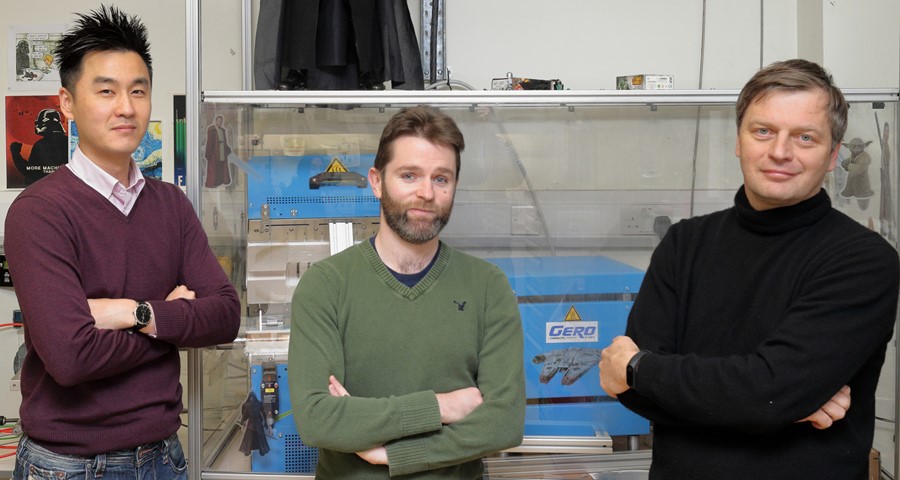Ultra-Fast, Ultra-Sensitive PtSe2 Gas Sensors
Gas sensors are in demand for a range of different applications. PtSe2 – a little-studied transition metal dichalcogenide – shows excellent promise for high performance gas-sensing and photovoltaics, with CMOS compatible fabrication. Image credit: Trinity College Dublin
Researchers from the Graphene Flagship, working at the AMBER centre in Trinity College Dublin, Ireland in collaboration with researchers from University of Siegen, Germany, and University of Vienna, Austria, have demonstrated ultrafast and highly sensitive gas sensors using platinum selenide (PtSe2). This material – a transition metal dichalcogenide (TMD) – has promising potential in different areas of nanoelectronics, including optoelectonics as well as sensing.
The Graphene Flagship is dedicated to the development of new technologies based on graphene and related layered materials, such as TMDs. Layered materials have several different properties; some, such as boron nitride are insulators, while TMDs are typically semiconductors. As the family of layered materials grows, the investigation of new materials leads to more freedom to choose the materials with the best properties when designing for specific requirements. This research, published in ACS Nano, demonstrates the potential of PtSe2 in a range of applications, and presents this little-studied material as an excellent candidate for further investigation.
The new TMD was created using a metal conversion method, in which thin platinum film is converted into PtSe2 by thermally assisted conversion in selenium vapour at 400 °C. PtSe2 now joins the growing class of stable TMDs. Georg Duesberg, from Trinity College Dublin, is the principal investigator of the study. He said “We performed a screening study of materials, to check a few different material combinations. The conversion of metals is helpful in the quest for new materials, because it is simple to do. Of the other combinations that worked, many immediately oxidised, so they were not stable. We were very lucky to find a sweet spot with this material, and to be able to synthesise it on a large scale.”
One of the benefits of PtSe2 is the method of fabrication, which is compatible with silicon chip fabrication. “We grow PtSe2 at 400°C which makes it potentially suitable for so-called back end of line (BEOL) processing. This means that it can be combined with existing device architectures to add new functionality,” said Niall McEvoy, a researcher at Trinity College Dublin who performed the growth experiments. BEOL processing comes after the actual fabrication of integrated circuits of a silicon chip, It is crucial that the temperature is less than 450 °C, to preserve the functionality of the integrated circuit. “This is very interesting for the Flagship’s push towards industrial applications,” added Duesberg. “This potentially can be grown on top of a chip. You can imagine using this material for the Internet of Things, sensors and so on.”
To demonstrate possible applications for the new material, the researchers tested its performance in sensing NO2. “All of our homegrown materials are tested as gas sensors. PtSe2 showed excellent results, high sensitivity, excellent response time and nearly complete recovery,” said Kangho Lee, a researcher at Trinity College Dublin who performed the gas sensing experiments. Gas molecules adsorbed onto the surface of the PtSe2 change its conductivity, lowering the resistance. The researchers found that the PtSe2 had extremely high sensitivity, measuring 100 ppb NO2 at room temperature. The sensor was also extremely fast to respond to the gas – detecting low quantities of gas in only seconds – and recovering completely within a minute when the inert atmosphere was restored. "TMDs complement graphene in sensor applications. They share the extreme sensitivity based on the layered nature, and the bandgap allows different readout principles with potentially low power consumption,” said Sanna Arpiainen, a senior researcher at VTT Technical Research Centre, Finland and the deputy leader of the Graphene Flagship’s Sensors Work Package.
For commercial sensing applications, the sensor must be responsive only to specific gases, so that changes in environmental conditions can be monitored. McEvoy is optimistic that the PtSe2 can be treated to have the selective sensing properties needed. “With some added processing steps, to engender selectivity, PtSe2 could potentially be used in a wide array of industrial chemical sensing applications,” he said. A potential route to selective sensing could be the addition of chemical groups that are responsive to the chosen gas. “In selectivity, the problems are similar to graphene gas sensors, which were also first demonstrated with the direct adsorption of NO2 but now rely on specific functionalisation. In some cases, this may be directly applicable to TMDs,” added Arpiainen.
The researchers also demonstrated a photovoltaic effect in the material in a photosensitive Schottky barrier diode, suggesting potential for use in solar cells. In this early stage, PtSe2 appears to be a very promising material for a variety of functions, not least because of its compatibility with chip fabrication. “Theory also tells us that the material should do very well in terms of mobility and so on, so in this regard our results seem to indicate that there are other materials out there that might be better for some applications than what’s been investigated so far,” said Duesberg.
Further Reading
1. Chanyoung Yim, Kangho Lee, Niall McEvoy, Maria O’Brien, Sarah Riazimehr, Nina C. Berner, Conor P. Cullen, Jani Kotakoski, Jannik C. Meyer, Max C. Lemme, Georg S. Duesberg, ACS Nano, 10, 9550 (2016)
2. Maria O'Brien, Niall McEvoy, Carlo Motta, Jian-Yao Zheng, Nina C Berner, Jani Kotakoski, Kenan Elibol, Timothy J Pennycook, Jannik C Meyer, Chanyoung Yim, Mohamed Abid, Toby Hallam, John F Donegan, Stefano Sanvito, Georg S Duesberg, 2D Materials, 3, 021004 (2016)

Left to right: Kangho Lee, Niall McEvoy and Georg Duesberg.
Image credit: Trinity College Dublin
This is very interesting for the Flagship’s push towards industrial applications...you can imagine using this material for the Internet of Things, sensors and so on.”
Principle investigator



